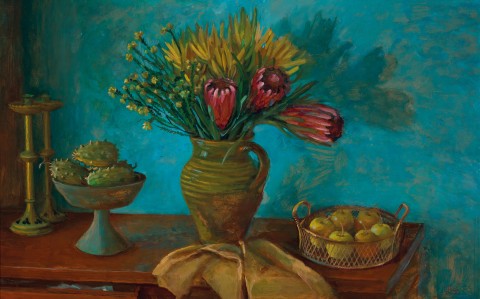PROTEA AND FRUIT, 1976
MARGARET OLLEY
oil on composition board
75.0 x 120.0 cm
signed lower right: Olley
Holdsworth Galleries, Sydney (label attached verso)
Private collection, Sydney
Thence by descent
Private collection, United Kingdom
An exhibition of recent works by Margaret Olley, Holdsworth Galleries, Sydney, 28 September – 16 October 1976, cat. 15
The Olley Project https://ehive.com/collections/5439/objects/465668/protea-and-fruit (accessed 30/03/23)
‘…I can think of no other painter of the present time who orchestrates his or her themes with such richness as Margaret Olley. She is a symphonist among flower painters; a painter who calls upon the full resources of the modern palette to express her joy in the beauty of things.’1
A much-loved, vibrant personality of the Australian art world for over 60 years, Margaret Olley exerted an enduring influence not only as a remarkably talented artist, but as a nurturing mentor, inspirational muse and generous philanthropist. Awarded an Order of Australia in 1991 and a Companion of the Order of Australia in 2006, Olley featured as the subject of two Archibald-Prize winning portraits (the first by William Dobell in 1948, and the second by contemporary artist Ben Quilty in 2011, just prior to her death) and was honoured with over 90 solo exhibitions during her lifetime, including a major retrospective at the Art Gallery of New South Wales in 1997. Today her work is held in all major state and regional galleries in Australia, and the myriad contents of her Paddington studio have been immortalised in a permanent installation at the Tweed Regional Gallery in northern New South Wales, not far from where Olley was born. Bequeathing a legacy as bountiful as the subject matter of her paintings, indeed her achievements are difficult to overstate – and reach far beyond the irrepressible sense of joy her art still brings.
A striking example of the still-life scenes for which Olley remains widely celebrated, Protea and Fruit, 1976 encapsulates well the way in which she repeatedly turned to the quotidian for inspiration, excavating her domestic setting to uncover the beauty inherent in everyday life. Such impression of familiarity is aided by Olley’s selection of items here that are eminently unpretentious - native wildflowers in an stoneware jug, a compote of spiny cucumbers and basket of apples, pair of rustic brass candlesticks and a folded saffron-coloured cloth resting casually on the wooden table as if the artist had placed it there only moments before. Significantly, the whole arrangement is enlivened by its juxtaposition against a vivid teal background - a vibrancy typical of Olley’s work during the seventies when she increasingly experimented with the chromatic possibilities of her art. For indeed, notwithstanding the apparent randomness of her arrangements, always underlying such compositions was the artist’s careful ‘orchestration’ of elements to create a harmonious, perfectly balanced image – an aesthetic originally inspired by her firsthand experience of the theatre in 1948 when she assisted with painting the sets for Sam Hughes’ productions of Shakespeare’s Pericles and Cocteau’s Orphée (designed by Jean Bellette and Sidney Nolan respectively).
Paying homage to the great European masters of her métier such as Vermeer, Bonnard, Matisse and Cézanne, thus Olley meticulously choreographs the various components of her exquisite still lifes as if actors on a stage – objects both commonplace and beautiful, shuffled this way and that, plunged into deep shadow or transformed by lighting. Leading the viewer’s eye and mind through an intimate, deeply personal drama that resonates with the artist’s delight in her domestic surrounds, each composition reveals the very essence of her identity; as Barry Pearce elucidates, ‘…to live with a Margaret Olley painting is to experience the transfiguration of a passionate, highly focused personality into art. In her paintings, the space surrounding each bowl of fruit, each vase of flowers, and through which the eye traverses a cacophony of surfaces such as patterned carpets, modulated walls, and cluttered tabletops, resounds with her presence. These are reflections of the things she loves, and which embellished the centre of how she prefers her existence to be.’2
1. Gleeson, J., ‘Introduction’, Margaret Olley, The Johnstone Gallery, Brisbane, 1964, n.p.
2. Pearce, B., ‘Margaret Olley Retrospective’, State of the Arts, Sydney, August – November 1996, p. 5
VERONICA ANGELATOS
